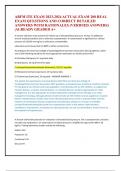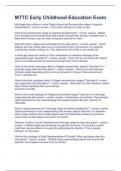ABFM ITE EXAM 2023-2024 ACTUAL EXAM 200 REAL
EXAM QUESTIONS AND CORRECT DETAILED
ANSWERS WITH RATIONALES (VERIFIED ANSWERS)
|ALREADY GRADED A+
A 42-year-old Asian male presents for follow-up of elevated blood pressure. He has no additional
chronic medical problems and is otherwise asymptomatic. An examination is significant for a blood
pressure of 162/95 mm Hg but is otherwise unremarkable.
Laboratory work shows that his BMP is within normal limits.
According to the American College of Cardiology/American Heart Association 2017 guidelines, which
one of the following would be the most appropriate medication to initiate at this time?
A) Clonidine (Catapres), 0.1 mg twice daily
B) Hydralazine, 25 mg three times daily
C) Lisinopril/hydrochlorothiazide (Zestoretic), 10/12.5 mg daily
D) Metoprolol tartrate (Lopressor), 25 mg twice daily
E) Triamterene (Dyrenium), 50 mg daily - ANSWER-ANSWER: C
This patient has hypertension and according to both JNC 8 and American College of
Cardiology/American Heart Association 2017 guidelines, antihypertensive treatment should be initiated.
For the general non-African-American population, monotherapy with an ACE inhibitor, an angiotensin
receptor blocker, a calcium channel blocker, or a thiazide diuretic would be appropriate for initial
management. It is also appropriate to initiate combination antihypertensive therapy as an initial
management strategy, although patients should not take an ACE inhibitor and an angiotensin receptor
blocker simultaneously. Studies have shown that blood pressure control is achieved faster with the
initiation of combination therapy compared to monotherapy, without an increase in morbidity.
Lisinopril/hydrochlorothiazide would be an appropriate choice in this patient. Alpha blockers,
vasodilators, beta-blockers, and potassium-sparing diuretics are not recommended as initial choices for
the treatment of hypertension.
A 36-year-old female presents for evaluation of elevated blood pressure. She is asymptomatic and does
not take any medications. On examination her blood pressure is 160/96 mm Hg and her BMI is 26
kg/m2. Fasting laboratory studies include the following:
Sodium 142.
Potassium 3.0.
Creatinine 0.76.
Glucose 97.
,Which one of the following additional laboratory evaluations should be performed to assess her blood
pressure?
A) A 24-hour urine collection for 5-hydroxyindoleacetic acid (5-HIAA)
B) A serum aldosterone/renin ratio
C) A serum cortisol level
D) A serum cystatin C level - ANSWER-ANSWER: B
Primary hyperaldosteronism should be suspected as a cause for hypertension if a patient has a
spontaneously low potassium level or persistent hypertension despite the use of three or more
antihypertensive medications, including a diuretic. This can be evaluated by checking a serum renin
activity level and a serum aldosterone concentration and determining the aldosterone/renin ratio.
Primary hyperaldosteronism typically presents with a very low serum renin activity level and an elevated
serum aldosterone concentration.
A 24-hour urine collection for 5-hydroxyindoleacetic acid (5-HIAA) would be used to evaluate for a
neuroendocrine tumor, which can present as chronic flushing and diarrhea. Cortisol levels can be
checked if Cushing syndrome is suspected. Hypertension can be present in Cushing syndrome, but it is
typically associated with other signs such as obesity and an elevated blood glucose level due to insulin
resistance. Cystatin C is a marker of renal function and measurement would not be indicated given this
patient's normal creatinine level.
A 26-year-old male diagnosed with coccidioidomycosis (valley fever) develops a rash on the extensor
surfaces of his lower legs consisting of painful, subcutaneous, nonulcerated, erythematous nodules. This
rash is consistent with which one of the following?
A) Erythema ab igne
B) Erythema infectiosum
C) Erythema migrans
D) Erythema multiforme
E) Erythema nodosum - ANSWER-ANSWER: E
Erythema nodosum, a panniculitis that typically affects the subcutaneous fat on the anterior surface of
the lower legs, is associated with coccidioidomycosis (valley fever) and can suggest the diagnosis. It is a
manifestation of the patient's immune response and often indicates a good prognosis. In addition to
coccidioidomycosis, it can also be associated with streptococcal infections as well as tuberculosis.
Erythema ab igne is a cutaneous rash caused by prolonged heat exposure (such as a heating pad)
presenting as an otherwise asymptomatic, red, reticulated pattern on the skin. Erythema infectiosum is
associated with parvovirus B19 infection and is usually seen in young children. It manifests as an
,erythematous rash of the face (slapped cheek appearance), arms, and legs. Erythema migrans is an
expanding, erythematous, annular rash with or without central clearing and is often associated with tick
exposure (Lyme disease). Erythema multiforme consists of raised, annular, target-like lesions with
central erythema and is usually associated with herpes simplex virus type 1.
A 50-year-old male presents with chronic abdominal pain. A workup leads you to suspect peptic ulcer
disease, and you refer him for endoscopy, which shows a small duodenal ulcer. The endoscopist also
notes some small esophageal varices without red wale signs.
Further evaluation confirms that the patient has compensated cirrhosis in the setting of alcohol use
disorder. He readily accepts this diagnosis and enters an Alcoholics Anonymous program. His ulcer
symptoms resolve with antibiotic therapy for Helicobacter pylori. He says he has abstained from alcohol
for 6 weeks, and he would like to further reduce his risks from cirrhosis.
The most appropriate next step in the management of his esophageal varices would be:
A) octreotide (Sandostatin)
B) omeprazole (Prilosec)
C) propranolol
D) endoscopic variceal ligation
E) repeat endoscopy in 1-2 years - ANSWER-ANSWER: E
Primary prevention of variceal hemorrhage is an important consideration in the management of patients
with cirrhosis. Although this patient's varices were diagnosed incidentally, patients with cirrhosis and
clinically significant portal hypertension should be screened for varices every 2-3 years with
esophagogastroduodenoscopy (EGD). EGD can be deferred in patients with platelet counts
<150,000/mm3 and transient elastography with liver stiffness <20 kPa. Once esophageal varices are
identified, the criteria for initiating prophylaxis to prevent variceal hemorrhage is based on the risk of
bleeding. Findings associated with a high risk of bleeding include small varices in patients with
decompensated cirrhosis, small varices with red wale signs (thinning of the variceal wall), and medium
to large varices. Patients with small varices not meeting these criteria have a low risk of hemorrhage and
do not require prophylaxis. They should be rescreened with EGD every 1-2 years.
For patients requiring treatment due to high-risk features, options for primary prophylaxis of
hemorrhage include nonselective -blockers such as propranolol or endoscopic variceal ligation.
Treatment decisions are based on patient preference, other potential contraindications, and local
resources. The need for repeat endoscopy in these cases will depend on the clinical circumstances. If
nonselective -blockers are used, they should be continued indefinitely. Octreotide is only given
intravenously for acute hemorrhage. There is no evidence that omeprazole slows the progression of
esophageal varices.
, An 83-year-old female with a history of Alzheimer's dementia presents with concerns about worsening
agitation in the evenings. She is accompanied by her daughter who has power of attorney. The patient is
dependent on her daughter for all instrumental activities of daily living and requires assistance with
certain core activities of daily living such as dressing and bathing. She has no other chronic medical
problems. Her daughter states that starting around 4:00 p.m., the patient becomes increasingly
disoriented and agitated. There has been no physical aggression, but the daughter asks for medical
intervention to "help calm her down."
Which one of the following should you recommend initiating first for the management of this patient's
symptoms?
A) Sensory stimulation including touch and music
B) Cognitive training
C) Haloperidol
D) Quetiapine (Seroquel)
E) Valproic acid. - ANSWER-ANSWER: A
This patient is experiencing behavioral and psychological symptoms of dementia (BPSD) as her cognitive
and functional status decline. Evening agitation is a common form of BPSD, often referred to as
sundowning. As with most BPSD, a nonpharmacologic approach to improve agitation has much stronger
evidence for efficacy compared to a pharmacologic approach. A recent network meta-analysis showed
that sensory stimulation, including massage, touch, and music therapy, significantly outperforms
pharmacologic intervention (level of evidence 1a). Cognitive training, especially for BPSD in the context
of advanced dementia, does not have strong evidence to support its use. Pharmacologic intervention
should be initiated with caution given the potential for side effects, and should be a last resort in
situations where there is a risk of self-harm or harm to others.
A 62-year-old female underwent a total knee replacement 3 months ago. She has no other surgical
history and is in good health. Her dental office calls you to discuss antibiotic prophylaxis prior to a dental
cleaning.
Based on current guidelines, which one of the following would be most appropriate regarding antibiotic
prophylaxis prior to routine dental procedures in this patient?
A) No prophylaxis
B) Prophylaxis for 6 months post knee replacement
C) Prophylaxis for 1 year post knee replacement
D) Prophylaxis for 5 years post knee replacement
E) Prophylaxis for the patient's lifetime - ANSWER-ANSWER: A





